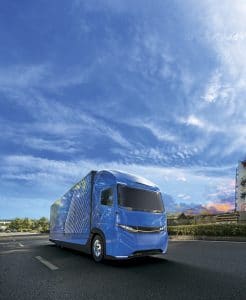
The Covid-19 pandemic seems to have accelerated the shift to electric CVs.
Story by Bhushan Mhapralkar
In November 2020, a little known company called Infraprime Logistics announced that it is rolling out 1000 heavy-duty electric trucks post the successful run of its 55-tonne prototype. It stated that 12 of its e-trucks are already in operation on the Delhi-Jaipur highway with the support of two charging stations. A visit to what looks like a primitive website of the company, and it states that their e-trucks were developed in view of the real-time duty cycle and driving behaviour. If the pictures are any indication, the e-truck by Infraprime Logistics looks like it has a cabin and other aggregates borrowed from a Tata prime mover model. The older LPT range to be precise. Pointing at an attempt to retrofit a conventional truck – a 6×4 tractor-head of Tata make, with an electric powertrain and battery back (utilising the space behind the cab for the placement of an air-conditioned battery stack), the e-truck is claimed to offer features like regeneration. The regeneration ability of the electric powertrain technology aboard the truck is said to contribute 25 per cent of the duty cycle energy requirements. The e-truck, as per the company website, offers best-in-class energy consumption of 1.50 kWh per km. This amounts to 40 per cent less than the industry anticipated mileage in such trucks since no other truck is currently in commercial operation, the website states.
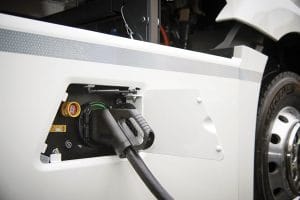
Emphasising on a right-sized drivetrain and optimum supply chain (that led to 20 per cent reduction in Bill-of-Material), the Infraprime Logistics website mentions that its e-trucks have one-fifth less moving parts. In the absence of a conventional powertrain, the company’s e-truck is claimed to profit from a considerable weight reduction. Said to feature an automatic transmission that keeps the motor turning in its sweet spot, the Infraprime Logistics heavy-duty e-truck’s battery stack, mentioned by sources aware of the development, has 4000 cycles of life. The battery pack, they added, is of the Lithium-Ion Phosphate variety. Rather than talk about the origin of the battery pack, the sources stated that the air-conditioned compartment based battery pack is placed such that it helps achieve a near ideal weight distribution. The lighter construction of the truck claimed to result in less tear and wear of brakes, its maker, Infraprime Logistics, is keen to convey that they used the right set of simulation tools to reduce the development time.
Retro is the word
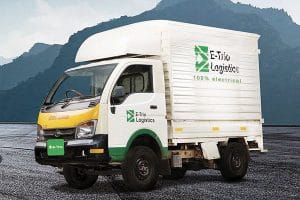
Similar looks to be an endeavour of a Hyderabad-based startup called Etrio Automobiles Pvt. Ltd. when compared to Infraprime Logistics. While Infraprime Logistics took to a heavy-duty e-truck, Etrio took to retro-fitment of mini-trucks that find use in typical urban applications like FMCG, white goods, farm produce, e-commerce, etc. The retro-fitment initiative saw the company borrow a cabin and chassis of an existing Tata Ace mini-truck. A look at the Etrio e-truck and it is evident. Contributing to the rising e-truck thrust in India, at least at the urban applications levels where attention to bring down pollution is being given much thought by the concerned governments and even the government at the centre, the Etrio e-LCV is about developing an e-truck with less development costs and time too. It is about a retro-fitment formula that entails borrowing existing CV aggregates – some of them at least, to come up with an e-vehicle. Retro-fitment endeavours truly they are. They are not so much about ground-up efforts, and more about bringing something new to the table. They are about having to carry little baggage. They are about experimenting, about risking more, and about projecting out of the box solutions to today’s challenges. Indicate of a drastic shift in the manufacturing landscape, startups like Infraprime Logistics and Etrio Automobiles may succeed or not succeed, they will leave their mark for sure. They will be looked upon as companies that accelerated electric CVs in India.
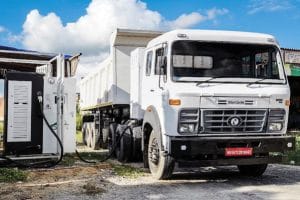
The earlier adoption of e-CVs, including e-trucks, is looking increasingly inevitable. Especially with regulations flying thick and fast, and efforts being made to lower the freight rates come what may. Rising fossil fuel costs, consumables, compliance costs and various other challenges making it difficult for BSVI CVs to gallop. CV sales for the year 2020 have not been kind to BSVI CVs and all the new technology that has gone in them. It is evident that transporters in the current economic environment and with unprecedented challenges like Covid are finding it tough to go about their business. There’s simply not much demand to fuel their ambitions. Amid all this, retro-fitment initiatives for e-trucks could present a new horizon of hope. A hope that accompanies lower TCO, but poses new questions about the cost to the environment. The cost to the environment is clearly about the source of electricity, vehicle components and aggregates, use-ability and end of life journey.
Over and above the cost of e-CVs to the environment, hope is had from the fact that they could help achieve a much lower TCO. It could also help tide better over regulations, higher compliance costs and unprecedented challenges. Consider the rising e-commerce demand for example. Next could be the demand for trucks for vaccine logistics. Much dynamism at play, and understandingly so. IDTechEx, in its latest forecast report on ‘Electric Light Commercial Vehicles 2020’ has outlined the uptake of e-CVs – e-LCVs, across China, Europe and various other parts of the world. Projecting global sales of e-LCVs to exceed 2.4 million units annually by 2030. A big factor as per the report is the increased price sensitivity due to the fall in demand in areas of logistics other than e-commerce. Another key factor, as per the report, is the falling price of batteries. Given the typical running cycle of an LCV, which is rather continuous than those of cars, an e-LCV may be better off. It would be at a definitive advantage because of its ability to provide a much lower TCO. With issues like range anxiety being dealt with through smarter use of technology and materials, e-LCVs, the report states, are gaining good momentum among urban fleets. They are fueling the efforts of such fleets to devise charging strategies around a hub and throughout their operation radius.
Market insights and data driven
Marking a culmination of over two-year journey – from prototype to commercialisation, the retro-fitment efforts of Etrio Automobiles seem to be well-received at the moment. According to the company’s co-founder and CEO, Deepak MV, the e-LCV of the company has found a place with e-commerce and express delivery enterprises. Priced at Rs.7.75 lakh (on-road Delhi) and backed by a five-year battery warranty (of up to 1.3 lakh kms), the Etrio e-LCV is certified by ARAI. Offered with a one year warranty on auxiliary components, and a five-year powertrain warranty (of up to 1.5 lakh kms), the e-vehicle is claimed to have a payload-carrying capacity of up to 750 kg. It is promising 60 per cent operational cost saving. Said to have a place at Amazon, Delhivery, Ikea, Flipkart, Gati, Mahindra Logistics and BigBasket among others, the Etrio e-LCV, according to Deepak MV, has covered in excess of 40,000 km by carrying out more than 10,000 delivery assignments. It has gained from activities like driver training, effective use of telematics for staying connected and a data-driven approach (which encompasses charging infrastructure as well), he added.
Tested for over 1.5 lakh kms, the Etrio is claimed to cost Rupees-four per km. This effectively translates into a saving of Rs.2000 per month. In comparison to a used Tata Ace, which does about 80 km a day, the Etrio, according to Deepak, offers a similar or lower TCO. For a daily run of 100 km, the TCO of Etrio e-LCV is the same as that of a new Ace. Boasting of an intelligent architecture, the e-vehicle offers a certified range of 120 Km (chargeable with a 16-ampere home socket). It comes with a 180 cu. ft closed, high deck load body and is powered by a 20 kWh lithium-ion battery (with cooling). Propelled by a 15 kW motor that does 120 Nm of maximum torque, the e-LCV sports a compact e-axle and regenerative braking. It is fitted with an auto transmission and disc brakes at front and the rear. Fitted with waterproof electric connectors and a smart Battery Management System (BMS), the Etrio e-LCV is IP67 standard compliant. It is equipped with multiple failure protection control, a smart thermal management system and an advanced software. There is isolation protection, low flammability LFP cells, auto-charging cut-off, GPS, geofencing, remote immobilisation, predictive maintenance, drive diagnostics, and cell health and performance diagnostics as well.
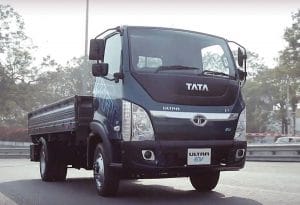
A new ecosystem
Using data to ensure remote health monitoring through relay of motor health, the health and state of electronics, and performance and efficiency, the Etrio e-LCV and Infraprime heavy-duty e-truck are said to be supported by smart apps. The two-point at an ecosystem that is data-driven and quite intensive too. Made somewhat easier perhaps because of their retro-fitment nature, the two electric-CVs are forebearers of a significant shift taking place in the Indian CV landscape. Underlining the development that e-CVs are accelerating, the two are announcing that electrification is no longer limited to buses. The effect of e-trucks is certain to show up in intra-city as well as inter-city logistics, sooner than later. Backed by Government policies to encourage localisation, electric technology is filtering into automobiles at almost all the levels. Neither are CVs immune, nor are even the farm tractors and off-highway equipment like backhoe loaders and excavators. Clearly, e-CVs are coming of age in India.
e-CVs are set to bridge the gap between optimisation of existing technologies and the advent of new technologies as far as emissions, and specifically the reduction of CO2 is concerned. With the need for lower TCO against the backdrop of government efforts to bring down freight rates as well as adhere to the Paris accord, e-CVs, e-trucks especially, are set to grow. They are also to lead a localisation strategy where most parts are locally sourced and locally made. As of current, some very critical parts are sourced from China and Taiwan. There is a cost implication to it. The new geo-political developments are however pointing at a shift; at the emergence of a new ecosystem that is increasing local and self-reliant. With many legacy CV manufacturers watching the efforts of companies like Infraprime e-truck and startups like Etrio e-LCV with interest, a stage is being set for an all-new CV ecosystem where a long-term technology agnostic roadmap paves the way. Where CVs with a capability to beat the railways at their own game, and offer transporters a new zest for business, emerge. The new age value trucks have shown how technology could help tackle disruption, and the next breed of CVs is set to elevate the game to a new level. It is set to help evolve a supply chain and logistics sector that is highly automated and among the most competitive. As attention shifts from B2B to B2C, a new-age of alternate fuel CVs is set. It could be hybrid CVs, electric CVs or hydrogen CVs. So far, the e-CVs seem to lead the way. Efforts like solar harvesting could add to their competitiveness.
…………………………………….
Inputs: Ashish Bhatia



















